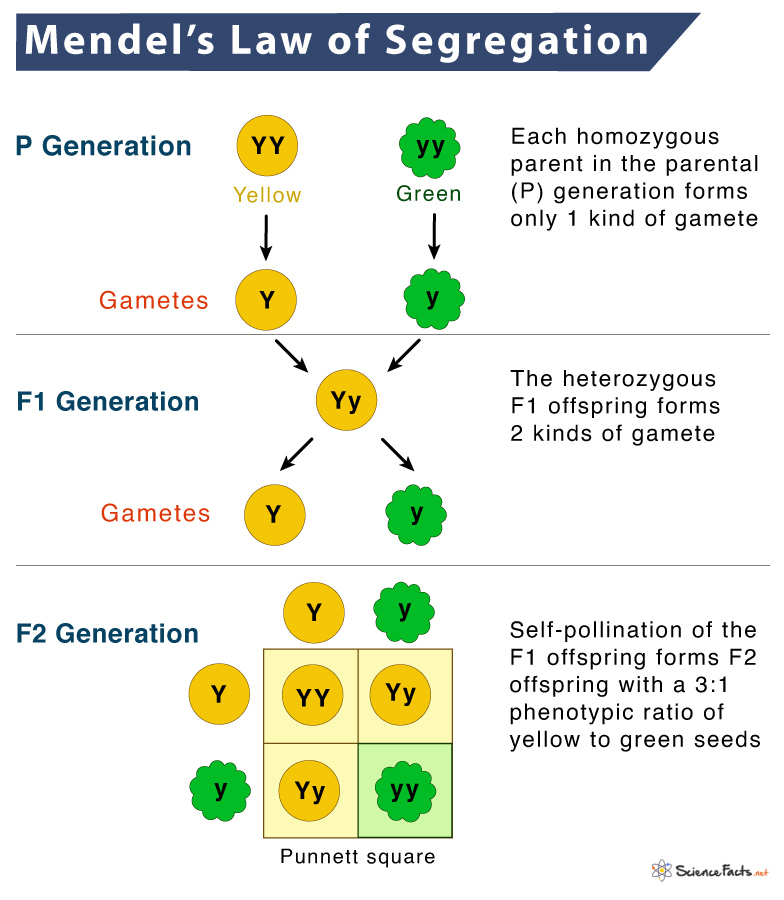Mendel’s Law of Segregation
Gregor Mendel, the father of genetics, put forward the laws that govern inheritance. He crossed two plants, each having two different alleles for a particular gene (heterozygous). He found that the traits in the offspring did not always match the traits of the parent plants.
From this result, Mendel put forward three laws of inheritance that could define the pattern of inheritance not only in pea plants but also in other organisms. They are the Law of Dominance, Law of Segregation, and Law of Independent Assortment.
Here, we will study the Law of Segregation in detail. The segregation law is also known as Mendel’s First Law of Genetics.
Law of Segregation
The law states that during the formation of a gamete, each gene separates from the other such that each gamete carries one allele for each gene. Thus, according to the law of segregation, the allocation of the gene copies is random.
When an egg and a sperm cell unite during fertilization, they form a new individual whose genotype consists of alleles in the gametes.
Basis of Segregation
The principle of segregation depends on four critical conclusions of Mendel:
- A gene can have more than one form or allele
- Offspring inherit two alleles for each trait or character
- When gametes are produced, allele pairs separate, leaving each cell with a single allele for each trait
- When the two allele pairs are different, one is dominant, and the other is recessive
Let us consider Mendel’s experiment with pea plants to reach his conclusion.
Law of Segregation Example
In pea plants, the gene for seed color exists in two forms (alleles). One of the alleles codes for yellow seed color (Y), whereas the other for green seed color (y). The allele for the yellow seed color is dominant over the green seed color, which is recessive.
As we know from Mendel’s monohybrid and dihybrid cross, when the alleles of a pair are different (heterozygous), the dominant trait is expressed, while the recessive trait is masked. The steps of the experiment are:
- In the parental generation, Mendel crossed a homozygous, dominant pea plant for yellow seed color (YY) with a homozygous, recessive pea plant for green seed color (yy).
- Each of the parents produces only one kind of gamete, Y from the YY allele and y from the yy allele.
- All the F1 generation offspring are heterozygous, with alleles having genotype Yy. Thus, phenotypically they all express the dominant trait that is yellow.
- The heterozygous F1 offspring produces two kinds of gametes, Y and y.
- Self-pollination of the F1 offspring produces the F2 generation offspring that are phenotypically in the ratio of 3:1. That is, three of the offspring develop the dominant yellow seed color. At the same time, the remaining shows the green seed color. This result is shown using a Punnett square.
In a Punnett square, all possible gametes from the two parents are arranged, one on the top, the other on the side. After self-fertilization, the same plant is both the parents. All the combinations are then written in the boxes, representing fertilization for making new individuals.
By studying the genotype and phenotype of the F2 offspring, Mendel found that seeds with the genotype of YY or Yy are yellow. In contrast, seeds with genotype yy are green.
Conclusion
The above experiment proves the law of segregation proposed by Mendel. The gametes formed during the parental (step 2) and F1 generation (step 4) carry only one allele for each gene. Furthermore, the outcome of the cross shows that both the parental alleles for the gene for seed color in pea plants have segregated into separate daughter cells or gametes.
FAQs
Q.1.Which scenario breaks the law of segregation?
Ans. The scenario that breaks the law of segregation is when a gamete produced has two identical alleles after the second round of meiosis.
-
References
Article was last reviewed on Friday, February 17, 2023




